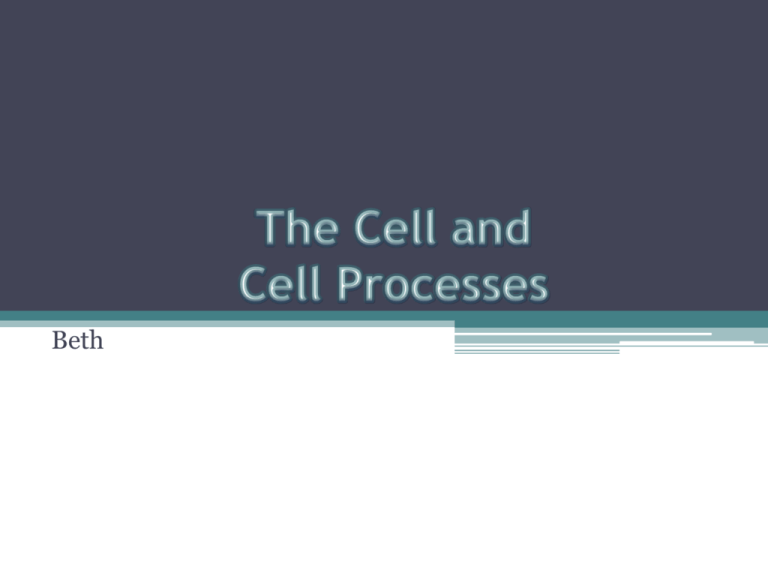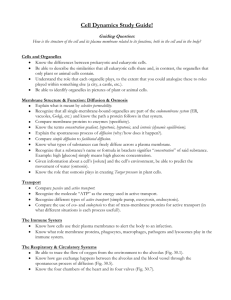Chapter 3 Review
advertisement

Beth Cytology The study of the structure and function of cells. Structures • • • • • • • • • • • • • • • • Cell Membrane Cytosol Cytoskeleton Microvilli Cilia Centrioles Ribosomes Mitochondria Nucleus Nucleolus Rough Endoplasmic Reticulum Smooth Endoplasmic Reticulum Golgi Apparatus Lysosomes Peroxisomes Nuclear Pores Functions • • • • • • • • • • • • • • • • Isolation and protection Distributes materials by diffusion Internal Support Absorption of extracellular material Movement of materials over surfaces Movement of chromosomes during cell division Protein Synthesis Produce 95% of the ATP required by the cell Control of metabolism Site of RNA synthesis Secretory protein synthesis Lipid and carbohydrate synthesis Storage, alteration, and packaging of secretory products and lysosomes Intracellular removal of damaged organelles or pathogens Neutralization of toxic compounds Allow the movement of ions and small molecules Cell Theory 1. Cells are the building blocks of all plants and animals. 2. Cells are produced by the division of preexisting cells. 3. Cells are the smallest units that perform all vital physiological functions. 4. Each cell maintains homeostasis at the cellular level. 5. Homeostasis at the tissue, organ, system, and individual levels reflects the combined and coordinated actions of many cells. Two most common methods used to study cell and tissue structure: • Light Electron Microscopy • Scanning Electron Microscopy Light Microscopy Can magnify cellular structures about 1,000 times and show details as fine as 0.25 µm (micrometer or micron). With a light microscope one can identify cell types and see large intracellular structures. Electron Microscopy Transmission Electron Microscopy Electrons pass through an ultrathin section to strike a photographic plate. Transmission Electron Microscopy shows the fine structure of cell membranes and intracellular structures. Scanning Electron Microscopy Electrons bouncing off exposed surfaces create a scanning electron micrograph. Although Scanning Electron Microscopy provides less magnification, it provides a three-dimensional perspective on cell structure. The Study of Cell Structure THE CELL Cell Membrane Cytoplasm Cytosol Organelles NonMembranous Organelles Membranous Organelles Non-membranous Organelles • Cytoskeleton • Microvilli • Centrioles • Cilia • Flagella • Ribosomes Membranous Organelles • Mitochondria • Nucleus • Endoplasmic Reticulum • Golgi Apparatus • Lysosomes • Peroxisomes The net movement of material from an area where its concentration is relatively high to an area where its concentration is relatively low. The difference between the high and low concentrations represents a concentration gradient and diffusion takes place until that gradient has been eliminated. Diffusion Important factors that influence Diffusion rates: Distance- The greater the distance, the longer the time required. Size of Gradient- The larger the concentration gradient, the faster diffusion proceeds. Molecular Size- Ions and small organic molecules such as glucose diffuse faster than large proteins. Temperature- The higher the temperature, the faster the diffusion rate. Diffusion (continued) Three major factors determine whether or not a substance can diffuse across a cell membrane. These major factors are lipid solubility, channel size, and electrical interactions. Osmosis The movement of water across a semipermeable membrane toward a solution containing a relatively high solute Three characteristics of osmosis should concentration. be remembered: 1. 2. 3. Osmosis is the diffusion of water molecules across a membrane. Osmosis occurs across a selectively permeable membrane that is freely permeable to water but not freely permeable to solutes. In osmosis water will flow across a membrane toward the solution that has the highest concentration of solutes, because that is where the concentration of water is lowest. Osmosis (continued) Isotonic is one that has the same solute concentration as does the cytoplasm. Hypotonic solution has a solute concentration lower than that of the cytoplasm. Hypertonic solution has a solute concentration higher than that of the cytoplasm. Facilitated Diffusion Receptor-Mediated Endocytosis • Produces vesicles that contain a specific target molecule in high concentrations. • Begins when materials in the extracellular fluid bind to receptors on the membrane surface. • Resembles pinocytosis, but is far more selective. Filtration Phagocytosis • Produces vesicles containing solid objects that may be as large as the cell itself. Active Active Transport Endocytosis • Carrier molecules work regardless of any concentration gradients. • Creation of vesicles containing fluid or solid material. • Gap Junctions- Two cells are held together by an interlocking of membrane proteins. • Tight Junctions- Partial fusion of the lipid portions of the two cell membranes. Cell Attachments Intermediate Junctions- The opposing cell membranes, while remaining distinct, are held together by a thick layer of proteoglycans. Desmosomes- There is a very thin proteoglycan layer between the opposing cell membranes. CELL ATTACHMENTS (CONTINUED) Junctional Complexes Hold together the cells lining passageways such as the digestive tract and respiratory tract. Interphase G0 Phase- the cell is not preparing for mitosis. G1 Phase- the cell manufactures enough mitochondria, centrioles, cytoskeleton elements, endoplasmic reticulum, ribosomes, Golgi bodies, and cytosol to make 2 functional cells. • S Phase- over the next 6-8 hours the cell duplicates itself. Interphase (continued) Gm Phase- begins mitosis. G2 Phase- the cell does last minute protein synthesis. 4 stages MITOSIS Begins when the chromosomes coil so tightly that they become visible as individual structures. As a result of DNA replication during the S phase, there are 2 copies of each chromosome, called chromatids, connected at a single point, the centromere. As the chromosomes appear, the 2 pairs of centrioles move apart. Spindle fibers extend between the centriole pairs; smaller microtubules radiate into the disappearance of the nuclear envelope. Stage 2: Metaphase The chromatids now move to a narrow central zone called the metaphase plate. A microtubule of the spindle apparatus attaches to each centromere. This stage is in many ways the reverse of prophase, the nuclear membranes form, the nuclei enlarge, and the chromosomes gradually uncoil. Once the chromosomes disappear, nucleoli reappear and the nuclei resemble those of interphase cells. Cytokinesis Is the separation of the two daughter cells. It usually begins in late Anaphase and continues through Telophase. The completion of cytokinesis marks the end of cell division.






